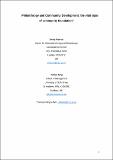Files in this item
Philanthropy and community development : the vital signs of community foundation?
Item metadata
| dc.contributor.author | Harrow, Jenny | |
| dc.contributor.author | Jung, Tobias | |
| dc.date.accessioned | 2017-01-02T00:32:13Z | |
| dc.date.available | 2017-01-02T00:32:13Z | |
| dc.date.issued | 2016-01 | |
| dc.identifier | 222561865 | |
| dc.identifier | 4b1f8078-bfa2-4a26-8c3c-ebf6c358761c | |
| dc.identifier | 84960109138 | |
| dc.identifier | 000368415800009 | |
| dc.identifier.citation | Harrow , J & Jung , T 2016 , ' Philanthropy and community development : the vital signs of community foundation? ' , Community Development Journal , vol. 51 , no. 1 , pp. 132-152 . https://doi.org/10.1093/cdj/bsv056 | en |
| dc.identifier.issn | 0010-3802 | |
| dc.identifier.other | ORCID: /0000-0002-9371-404X/work/57476297 | |
| dc.identifier.uri | https://hdl.handle.net/10023/10027 | |
| dc.description | This self-funded research builds on earlier support for the study of community foundations within philanthropy from the UK’s Economic and Social Research Council (ESRC), grant reference RES-593-25-0004. | en |
| dc.description.abstract | Increased funding pressures on community development and reductions in governmental funding for community support suggest potent roles for philanthropy as a funding source, and the possibility of changing relationships between community development and philanthropy. Focusing on English community foundations and their implementation of the Canadian Vital Signs initiative, which is geared towards assessing communities’ vitality and social priorities, our article explores whether, and how, such changes may be occurring. Using the literature on the respective value of ‘unsettling’ and ‘settled’ third sector organisations to community development, we reflect on the roles and contributions of community foundations to community development through community philanthropy. Vital Signs reports’ content indicates donor-led community philanthropy associated with ameliorative rather than fundamental social change positions, as well as uncertainty surrounding community leadership in this context. We identify community foundations as ‘settled’ organisations within the community development spectrum and as reflecting the ‘directed’ community development form. In this instance, it appears that the philanthropy-community development gap that we suggest is at best being partially bridged. Nevertheless, and paradoxically, these organisations’ achievement of financial security through community donorship could also strengthen their community leadership roles in ‘unsettling’ ways, so doing more to lessen philanthropy and community development’s separation. | |
| dc.format.extent | 437248 | |
| dc.language.iso | eng | |
| dc.relation.ispartof | Community Development Journal | en |
| dc.subject | Community foundations | en |
| dc.subject | Community development | en |
| dc.subject | Philanthropy | en |
| dc.subject | HN Social history and conditions. Social problems. Social reform | en |
| dc.subject | HC Economic History and Conditions | en |
| dc.subject | SDG 10 - Reduced Inequalities | en |
| dc.subject.lcc | HN | en |
| dc.subject.lcc | HC | en |
| dc.title | Philanthropy and community development : the vital signs of community foundation? | en |
| dc.type | Journal article | en |
| dc.contributor.institution | University of St Andrews. School of Management | en |
| dc.identifier.doi | 10.1093/cdj/bsv056 | |
| dc.description.status | Peer reviewed | en |
| dc.date.embargoedUntil | 2017-01-01 |
This item appears in the following Collection(s)
Items in the St Andrews Research Repository are protected by copyright, with all rights reserved, unless otherwise indicated.

